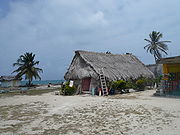The indigenous peoples of Panama, also known as Native Panamanians, are the original inhabitants of Panama, is the Native peoples whose history in the territory of today's Panama predates Spanish colonization. As of the 2010 census, Indigenous peoples constitute 12.3% of Panama’s population of 3.4 million, totaling just over 418,000 individuals. The Ngäbe and Buglé comprise half of the Indigenous peoples of Panama.[1]



Many of the Indigenous Peoples live on comarca indígenas,[2] which are administrative regions for areas with substantial Indigenous populations. Three comarcas (Comarca Emberá-Wounaan, Guna Yala, Ngäbe-Buglé) exist as equivalent to a province, with two smaller comarcas (Guna de Madugandí and Guna de Wargandí) subordinate to a province and considered equivalent to a corregimiento (municipality).
Indigenous groups
edit- Bokota, Bocas Del Toro
- Embera, southeastern Darién Province
- Ngäbe (including the Movere and Murire peoples), mainly Chiriquí Province
- Guna, Darién Province and Caribbean side.
- Buglé, mainly Chiriquí Province
- Talamanca
- Teribe[1]
- Wounaan, southeastern Darién Province
- Emberá-Wounaan, mainly Emberá-Wounaan Comarca
- Bribri
Languages
editSome native peoples speak Spanish, while many more retain their traditional languages. According to the 2000 census, the following indigenous languages are spoken in Panama:
- Bokota language: 933 speakers (in Panama)
- Bri-bri language: 2,521 speakers
- Buglé language: 17,731 speakers
- Emberá language: 22,485 speakers
- Guna Language: 61,707 speakers
- Naso-Teribe language: 3,305 speakers
- Ngöbe language: 169,130 speakers
- Wounaan language: 6,882 speakers[2]
Notes
edit- ^ a b "Panama History: Indigenous People." Archived 2010-11-25 at the Wayback Machine Panama Experts. (retrieved 23 Feb 2011)
- ^ a b "Indigenous Peoples in Panama." Archived 2011-03-02 at the Wayback Machine International Work Group for Indian Affairs. (retrieved 23 Feb 2011)